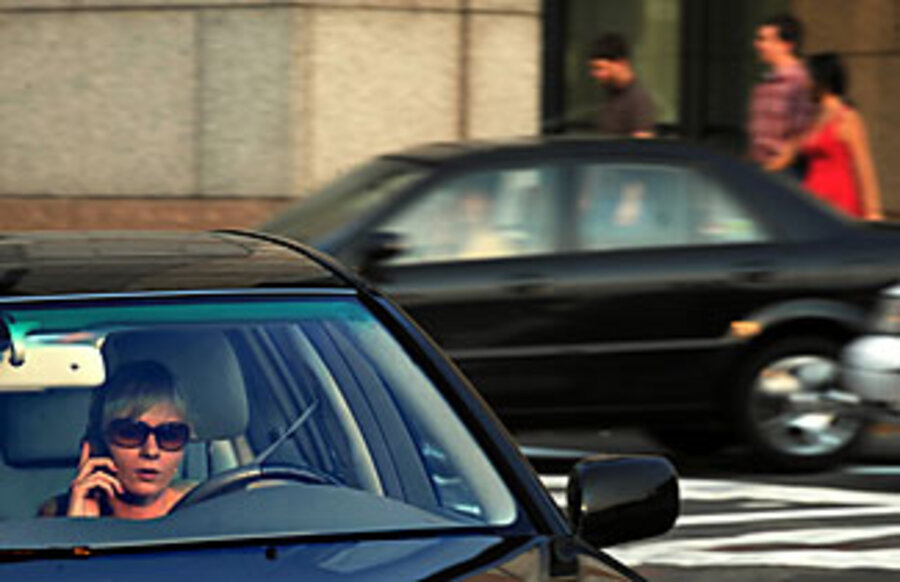The spread of bans on driving while texting
Loading...
| Los Angeles
The California legislator who championed the state's ban on using hand-held cellphones while driving has a new target: text messaging at the wheel.
When Sen. Joe Simitian (D) started work on the bill to mandate hands-free chatting for California's 23.6 million motorists in 2001, texting was barely in the lexicon of even the savviest techies. But that's all changed. Internet-ready smartphones are gobbling up the wireless phone market, letting users send text messages and check e-mail from just about anywhere.
In addition to California, legislatures in at least 13 other states are considering some kind of ban on drivers tapping out text messages. Four states have already made it illegal for motorists to send text messages. Another set of four states bans cellphones altogether for drivers under the age of 18.
While several studies link the use of hand-held phones to traffic accidents and fatalities, texting is too new to have received the same kind of scrutiny. But accidents around the country blamed on texting have drawn the public's attention. Most recently, texting appears to have played a role in a fatal hit-and-run on July 12 in Easton, Mass., according to the prosecutor in the case.
A May survey by Nationwide Insurance found that 18 percent of motorists who have cellphones text and drive simultaneously. The number rises among drivers 18 to 30 years old: In that age group, 39 percent of drivers say they attempt to balance texting and steering, according to the survey.
Senator Simitian says the issue of texting did come up before California adopted the hands-free law in 2006, but he didn't want to risk any further delays in putting into action what he calls a lifesaving measure. Since the law went into effect in July, he's been impressed not only with how well Californians have adapted to the regulations, but also with how the measure has raised awareness about an increasing number of distractions for motorists.
"It's been interesting to see how public opinion has evolved over the years. The public has been pretty supportive on the hands-free law," he says. With this acceptance has come a window of opportunity for new legislation restricting texting. If passed, a texting ban for California drivers could go into effect as early as Jan. 1.
Since laws prohibiting motorists from using hand-held phones went into effect in Washington and California this month, roughly a quarter of all American drivers aren't legally allowed to hold a cellphone while driving. Many experts say it's just a matter of time before the rest of the country's 196 million licensed drivers will have to use some kind of hands-free device if they want to make a call from the road.
So far, five states, plus the District of Columbia, require hands-free phones for motorists. But at least 22 other states are considering bills with similar restrictions.
"Fatalities in California should drop by about 300 a year, or 7 percent" as a result of the new law, says Jed Kolko, a research fellow at the nonprofit think tank Public Policy Institute of California (PPIC). He drew that conclusion from looking at the accident statistics in states that first passed hands-free laws.
"Laws requiring hands-free devices have reduced fatalities in adverse conditions by 30 to 60 percent, depending on how long the law has been in effect," according to the PPIC study by Mr. Kolko released in May.
But Carnegie Mellon University researchers concluded in March that the mere act of having a cellphone conversation impairs drivers' judgment. "Just listening to a cell phone while driving is a significant distraction, and it causes drivers to commit some of the same types of driving errors that can occur under the influence of alcohol," according to the study in the journal Brain Research.
Kolko, a proponent of California's hands-free law, agrees that it's not only the act of holding a cellphone that is distracting. Even dialing is dangerous, he says. "If all we cared about was making driving as safe as possible, the safest thing to do would be ban cellphone use altogether," he says. "But most people would like to see a balance."
While California drivers have overwhelmingly adapted to the new law, not everyone has been compliant. The California Highway Patrol issued at least 3,879 tickets statewide to drivers using hand-held phones between July 1 and 18.
Penalties in California start at $20 for anyone caught violating the hands-free law. But after penalties and local assessments are added, the actual fine can top $100.





